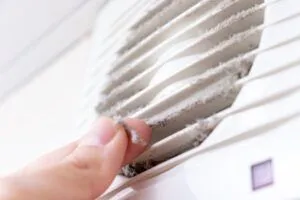
MERV stands for “Minimum Efficiency Reporting Values.” A MERV rating helps report an air filter’s ability to capture larger particles (between .30 and 10 microns). This means that the higher the MERV rating is, the better the air filter is at trapping particles.
These particles can include dust, allergens, and microorganisms, all things that nobody wants to flow in their airspace.
The MERV Rating Filter Chart
The MERV rating system was created by the American Society of Heating, Refrigerating, and Air Conditioning Engineers (ASHRAE). The MERV rating scale ranges from a score of 1 to 20, with a rating of 1 meaning that it does not have the best ability to catch and filter out smaller particles, while a rating of 20 does have the best ability.
According to the US Environmental Protection Agency (EPA), filters with MERV ratings of 1-4 deal with micron particle sizes of 10.0 which means the air filter can capture pollen, dust mites, and textile/carpet fibers. These air filters would usually be used in window air conditioning units and residential furnaces.
Filters with MERV ratings of 17-20 deal with micron particle sizes of less than 0.30 which means the air filter can capture virus carriers, carbon dust, and microscopic allergens. These air filters would usually be used in orthopedic surgery rooms and pharmaceutical manufacturing facilities.
It is important to note that having a lower MERV score does not mean that the air filter is less desirable. This is because you do not need an air filter with a MERV rating of 20 to catch all the microscopic allergens just for an air conditioning unit in a one-bedroom apartment. However, having an air filter for an air conditioning or heating unit in a surgical operating room would be crucial to people’s health and safety.
Alternative Air Filter Measurement Systems
A MERV rating is not the only way to measure an air filter’s ability to capture particles in the air. There are two other predominant air filter rating systems: the “Filter Performance Rating” (FPR) and the “Microscopic Performance Rating” (MPR). These other two air filter rating systems can be used alongside MERV ratings to help consumers pick the best air filter for their HVAC units.
The FPR scale gives the air filter a score between 1 through 10, with a rating of 1 meaning it is not the best at capturing small particles in the air while a rating of 10 means that it does have the best ability to do so. The MPR scale gives the air filter a score between 300 to 2200, with a rating of 300 meaning that the air filter is not the best at trapping small air particles, while a rating of 2200 means that it does have the best ability to do so. An FPR rating of 10 is equivalent to a MERV rating of 14 while a MERV rating of 20, its highest possible score, is only equivalent to a score of 1900 on the MPR scale.
Selecting the Right Air Filter for your HVAC System
The key to choosing the ideal air filter for your furnace or air conditioner is knowing how to balance both your HVAC unit’s capabilities and the indoor air quality you would like to achieve. This means that just choosing an air filter with the highest rating (MERV 20) is not exactly the simple and smart choice that one might presume. Having an air filter with a score of MERV 20 could actually end up damaging your furnace or air conditioner because it is not designed to take that kind of air filter.
It is important to keep in mind that as the MERV rating for the filter goes up, air flow goes down. This essentially forces your furnace or air conditioner to work twice or even three times as hard as it needs to in order to pump air throughout the building properly.
Always check to make sure to check your HVAC systems to see what kind of air filter they take and how high of a MERV rating they can handle. The ideal air filter MERV rating for home comfort and HVAC efficiency would be between 6 and 8.
Consider purchasing an entirely new and different furnace or air conditioning system if you and your family value place a lot of value on high-level indoor air quality. Do not just buy MERV 20 air filters when your HVAC cannot handle them. Ambient Edge is here to help with all your HVAC and air filter-related questions and with choosing the right air filtration systems for you.
Air Filter Health Implications
Some people base their choice of an air filter simply on what their HVAC unit will accept, while others base it on reducing their carbon footprint and helping the environment. Many people base their decision on the quality of airflow that their home will receive.
According to ASHRAE, particle filtration can be “modestly effective” in helping with people’s allergy and asthma symptoms. It does this by trapping dust, pollen, and mold spore particles in the filters, thus purifying the air in your home.
Air filters with high MERV and MPR ratings have also been known to decrease the concentration of infectious airborne particles, which helps stop the spread of communicable diseases. This is because air filters with a MERV rating of 16 – 20 can capture bacteria, virus carriers, and microscopic allergens from the air that you are breathing. It would be smart to invest in getting a new HVAC system that can handle air filters with high MERV and MPR scores if you and your loved ones are suffering from chronic breathing diseases and disorders.
How Ambient Edge Can Help
Not only can Ambient Edge help provide you with answers to your air filter questions, but we have a 24/7 installation service for when you do decide to improve the air quality and purchase new HVAC systems. This installation service also applies to making repairs to furnaces and air containers, including helping those who bought the wrong MERV-rated air filter and caused their HVAC system to break down. Contact us today, and our knowledgeable technicians can get to work helping you solve any allergy and energy-related issues in your home.


